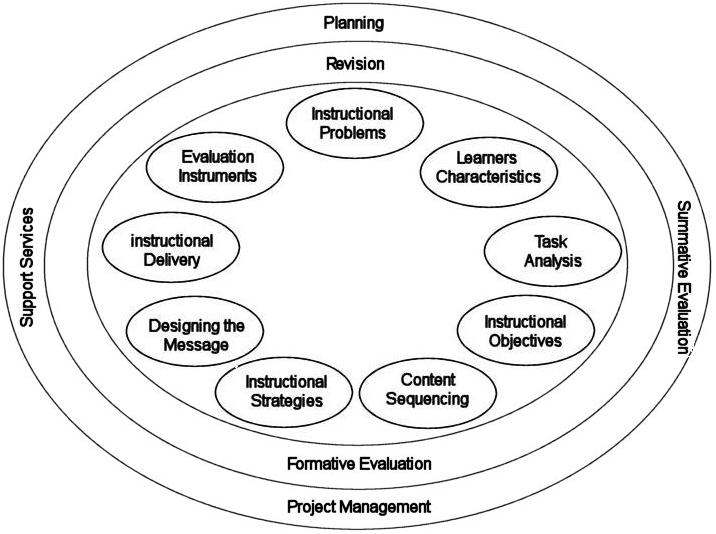Kemp design model
 From EduTechWiki - Reading time: 2 min
From EduTechWiki - Reading time: 2 min
Definition[edit | edit source]
The Jerold Kemp instructional design method and model defines nine different components of an instructional design and at the same time adopts a continous implementation/evaluation model.
Kemp adopts a wide view, the oval shape of his model conveys that the design and development process is a continuous cycle that requires constant planning, design, development and assessment to insure effective instruction. The model is systemic and nonlinear and seems to encourage designers to work in all areas as appropriate (Steven McGriff).
The model is particularly useful for developing instructional programs that blend technology, pedagogy and content to deliver effective, inclusive (reliable) and efficient learning.
The model[edit | edit source]
According to Steven McGriff's web page (retrieved 18:37, 19 May 2006 (MEST)), Kemp identies nine key elements
- Identify instructional problems, and specify goals for designing an instructional program.
- Examine learner characteristics that should receive attention during planning.
- Identify subject content, and analyze task components related to stated goals and purposes.
- State instructional objectives for the learner.
- Sequence content within each instructional unit for logical learning.
- Design instructional strategies so that each learner can master the objectives.
- Plan the instructional message and delivery.
- Develop evaluation instruments to assess objectives.
- Select resources to support instruction and learning activities.
According to Elena Qureshi's web-page on instructional design: “The Kemp (1994) design model takes a holistic approach to instructional design. Virtually all factors in the learning environment are taken into consideration including subject analysis, learner characteristics, learning objectives, teaching activities, resources (computers, books, etc.), support services and evaluation. The process is iterative and the design is subject to constant revision. The immediate feel of being iterative and inclusive, and particularly the fact that the central focus is the learner needs and goals are the strengths of this model. There is also a focus on content analysis, as there would be in any educational design and a focus on support and service, which is not present in other ID models. Much like the Knirk and Gustafson design model, Kemp's model is also small scale and can be used for individual lessons.”
Links[edit | edit source]
- Elena Qureshi & Larry Morton (2006) http://lts.ncsu.edu/guides/instructional_design/selecting_models2.htm (Large web page with good comments, good for comparison also), retrieved 17:42, 19 May 2006 (MEST).
- http://www.quasar.ualberta.ca/edit573/modules/module4.htm
- Steven McGriff's Instructional Systems Design Models page HTML
- Steven McGriff's Kemp Model Page HTML.
References[edit | edit source]
- Gustafson, K., & Branch, R. M. (1997). Instructional design models. Syracuse, NY: ERIC Clearinhouse on Information and Technology.
- Kemp, J. (1977) Instructional Design: A plan for unit and course development. Belmont: Fearon-Pitman Pub.
- Morrison, G. R., Ross, S. M., & Kemp, J. E. (2004). Designing effective instruction (4rd ed.). New York: John Wiley & Sons, Inc.
 KSF
KSF